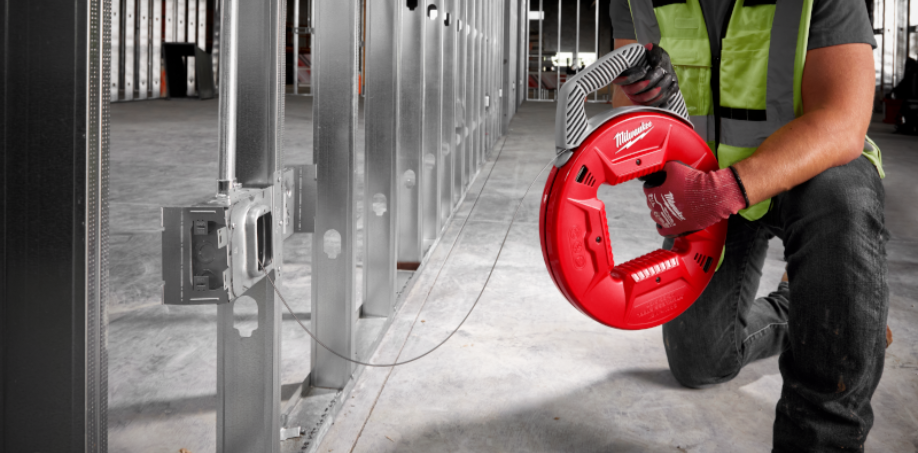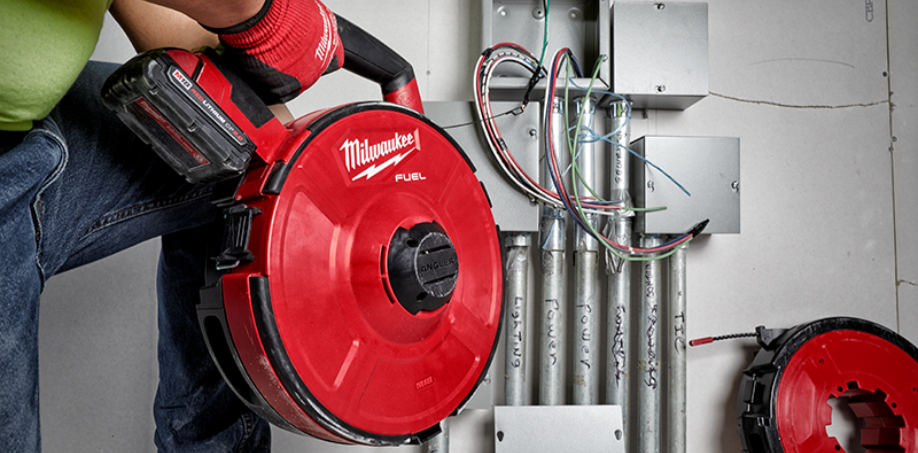Fish Tape: What it is and How to use it

Fish tapes are an important tool used throughout electrical installations. Available in both manual and electric versions, fish tapes help pull cables through walls, ceilings, or conduits. In this blog, we take a look at Fish Tape, what it is, how to use it, and a feature on the Milwaukee M18 FUEL Angler Fish Tape Kit. We'll also cover the differences between electric and manual fish tapes, and provide guidance to help you make the best choice when choosing between fish tapes.
What is Fish Tape?
Fish tape is a tool used by electricians to guide electrical cables through enclosed spaces, such as behind walls or within conduits. They are made from flexible materials like steel or polyester, fish tape is stored in a circular plastic casing, allowing for easy extension and retraction. Available in lengths ranging from 25 to 200 feet, it simplifies cable installation in hard-to-reach areas without causing damage to walls or structures. Fish tape comes in two main types: conductive, typically made of steel, and non-conductive, often crafted from fiberglass or polyester. The choice between conductive and non-conductive tape depends on the application, with non-conductive options preferred for safety around live wires.

How to use Fish Tape
Whether you are using a manual or electric fish tape, the basic process for pulling wires through a conduit or wall remains the same. Here's a step-by-step guide to using fish tape:
Prepare the Fish Tape: First, unreel a portion of the fish tape from its housing. Only extend enough tape to reach through the conduit or wall.
Feed the Fish Tape Through: Push the fish tape through the conduit or hole in the wall. If you encounter resistance, gently guide the tape through the bend. In some cases, a wire-pulling lubricant can help reduce friction and make it easier to feed the tape through tight spaces.
Attach the Wire: Once the end of the fish tape reaches the other side, strip the electrical wire’s sheathing to expose a small portion of the wires inside. Securely twist the wires together and form a loop at the end. Attach the loop to the end of the fish tape, then wrap it tightly with electrical tape to ensure a smooth pull.
Pull the Tape Back: Now that the wire is attached, pull the fish tape back through the conduit.
Detach the Wire: Once the wire has been pulled through, unwrap the electrical tape and detach the wire from the fish tape. Be sure to leave enough wire at both ends to make your electrical connections easily.
Reel in the Fish Tape: Finally, reel the fish tape back into its housing. Make sure the tape is clean and dry before storing it, particularly if it has been exposed to moisture, as this can help prevent rust and prolong the life of your fish tape.

The Milwaukee M18 Fish Tape Kit
The Milwaukee M18 Angler Fish Tape is an innovative tool that has transformed the wire-pulling process. Part of Milwaukee’s popular M18 FUEL line, this electric fish tape system is designed for professionals looking for efficiency, reliability, and ease of use. Key Features of the Milwaukee M18 Angler Fish Tape:
Automatic Feed and Retract: The standout feature of the Milwaukee electric fish tape is its automatic feed and retract mechanism. This system allows users to extend and retract the tape with the push of a button, eliminating the need for manual cranking. This feature not only saves time but also reduces physical strain.
Interchangeable Cartridges: The Milwaukee M18 fish tape is compatible with a variety of interchangeable cartridges, including steel and non-conductive fiberglass tapes. This versatility makes it suitable for different applications, whether you’re working with live circuits or need the added strength of steel tape for long pulls.
Powered by M18 FUEL Technology: The Milwaukee electrical fish tape is equipped with Milwaukee’s brushless motor technology, providing consistent power and longer tool life. The M18 FUEL technology ensures that the tool can handle even the most challenging wire pulls, making it a reliable choice for professionals.
Ergonomic Design: The tool is designed with user comfort in mind, featuring an ergonomic handle and balanced weight distribution. The compact design allows for better control and maneuverability, especially in tight spaces.

Electric Fish Tape vs. Manual Fish Tape
When comparing electric fish tape, like the Milwaukee M18 Fuel Angler, to traditional manual fish tape, there are several key differences that can influence which type is most appropriate for a specific job.
Manual Fish Tape: Manual fish tape has been a staple in the electrician’s toolkit for decades. It is affordable, simple to use, and effective for smaller jobs or installations. However, manual fish tape can be labor-intensive, particularly for longer cable runs or when dealing with multiple bends. Electricians have to manually feed the tape through the conduit and then pull it back out once the wire is attached.
Electric Fish Tape: On the other hand, electric fish tapes like the Milwaukee M18 Fish Tape are designed to minimize physical effort and improve efficiency. The powered feed and retract functions mean that the tape is automatically extended or reeled in at the push of a button, saving significant time on long runs.
In terms of cost, electric fish tapes are more expensive than manual fish tapes, but for professionals handling large-scale projects or regular installations, the investment can quickly pay off, with increased productivity and reduced physical strain.
Fish tape is an important tool for electricians and professionals who regularly install wiring in confined or difficult to reach spaces. While manual fish tapes are effective for smaller or simpler tasks, electric fish tapes, such as the Milwaukee electrical fish tape, offer a more efficient, user-friendly solution for larger projects. By understanding the differences between manual and electric fish tapes and knowing how to use them correctly, you can tackle any wiring project with confidence. Explore our available fish tapes, here. If you have any questions or would like to make a purchase, give our sales team a call at 877-446-4352.

